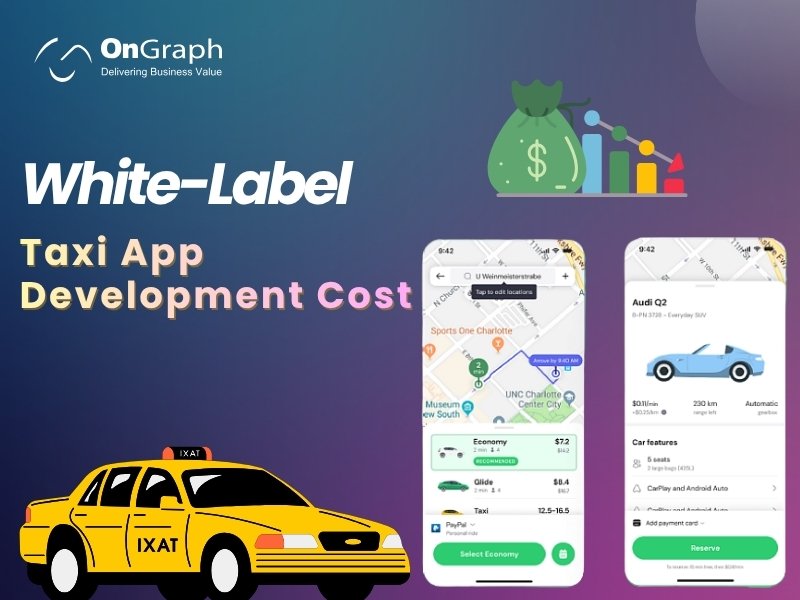In this article
- What Is a White Label Taxi App?
- Average White Label Taxi App Cost in 2025
- Key Factors Affecting Taxi App Development Cost
- Real Example: Cost Comparison Case Study
- White Label vs Custom Development
- Cost Breakdown by Module
- Cost of Modern Taxi App Features (Add-Ons)
- Hidden Costs Many Companies Miss
- 2025 Trends Impacting Ride-Hailing App Development Cost
- How to Reduce White Label Taxi App Cost (Expert Tips)?
- Best Countries to Outsource Taxi App Development in 2025
- Final Cost Summary
The question “What is the White-Label Taxi App Development cost in 2025?” is one every modern fleet owner asks before going digital.
With the global ride-hailing market expected to reach $220.5 billion by 2030 (Statista), having your own branded taxi app is no longer optional — it’s essential for staying competitive.
A white-label taxi app helps you launch faster by providing a ready-made solution you can fully rebrand and customize for your business.
Compared to building from scratch, it cuts both time and taxi app development cost dramatically.
This article provides a transparent breakdown of white-label taxi app development costs, pricing, and customization options, along with case studies, global benchmarks, and cost-saving strategies to help you make the best investment decision.
What Is a White-Label Taxi App?
A white label taxi app is a pre-built, customizable platform that includes passenger, driver, and admin apps. It’s designed to replicate proven models like Uber or Lyft — but tailored to your brand, fleet size, and region.
Typical modules include:
- Passenger App: For ride booking, fare estimation, tracking, and payments.
- Driver App: For accepting rides, earnings tracking, navigation, and chat.
- Admin Panel: For dispatch control, fare setup, user management, and reports.
- Dispatcher Console: For manual bookings and driver assignment (optional).
Choosing a white label solution means most of these features are already built and tested — you only pay for branding, deployment, and customization.
Average White Label Taxi App Cost in 2025
The average white-label taxi app development cost in 2025 ranges between $8,000 to $60,000, depending on region, complexity, and number of apps (user + driver + admin).
| Type of Solution | Estimated Cost (USD) | Development Time | Description |
| Basic Readymade Taxi App | $8,000 – $15,000 | 4–6 weeks | Ready-to-launch with limited customization |
| White Label Ride Sharing App | $15,000 – $30,000 | 6–8 weeks | Full branding, Stripe payment, dispatch module |
| Custom Taxi App (Hybrid) | $30,000 – $60,000 | 8–12 weeks | Custom UI, mixed fare zones, real-time tracking |
| Uber Clone App Development Cost (Custom) | $80,000 – $150,000+ | 16–24 weeks | Built from scratch with complete scalability |
Key Factors Affecting Taxi App Development Cost
Let’s break down what really influences your taxi booking app development cost in 2025.
1. Platform Selection
- Single Platform (Android/iOS): Cheaper, ideal for pilot phase.
- Cross-platform (Flutter, React Native): Reduces dual-app cost by 30–40%.
- Native Development (Swift/Java): Best performance, higher cost.
2. Feature Complexity
Basic ride booking costs less. But if you add real-time tracking, AI-based dispatch, or zone-based fares, the custom taxi app development cost rises.
Modern Taxi App Features include:
- Multi-city fare management
- Surge pricing / dynamic fare calculation
- SOS emergency alerts
- Wallet & loyalty points
- Chat and push notifications
- Stripe / PayPal / Razorpay integration
- Ratings, analytics, and driver reports
Also read – Top 10 Modern Taxi App Features to Boost Your Ride Business
3. UI/UX Design Quality
Custom design increases cost but improves user trust and retention. Remember, app design influences 75% of first-time user impressions (UXCam 2025).
4. Backend & Dispatch Software
The taxi dispatch software cost can make up 40% of the total pricing. It manages bookings, driver allocation, and route optimization in real time.
5. Developer Location
| Region | Hourly Rate | Estimated Cost (Full Project) |
| India / Southeast Asia | $20–$40/hr | $8,000–$25,000 |
| Eastern Europe | $40–$80/hr | $25,000–$50,000 |
| North America | $100–$150/hr | $60,000–$150,000 |
Real Example: Cost Comparison Case Study
A mid-sized taxi company in the U.S. chose a white label ride-sharing app instead of a full custom build.
| Approach | Total Cost | Time | Outcome |
| Full Custom (Native) | $120,000 | 9 months | Delayed launch, high maintenance |
| White Label with Custom Zones | $35,000 | 7 weeks | Fast launch, 68% cost savings |
Result: The company went live two months earlier, gained 1,200 drivers, and improved ROI by 54% in the first quarter.
White Label vs Custom Development
| Criteria | White Label Taxi App | Custom Taxi App |
| Time to Market | 4–8 weeks | 6–12 months |
| Cost | $10k–$40k | $80k–$150k |
| Source Code Ownership | Shared / Licensed | 100% yours |
| Scalability | Moderate | High |
| Customization | Moderate | Unlimited |
| Maintenance Cost | Lower | Higher |
Recommendation:
Start with a trusted White-Label Taxi App Development Company to launch your platform quickly, validate your operations, and build market traction. Once your base system is stable and generating consistent rides, you can gradually invest in advanced custom modules like dynamic pricing, real-time analytics, and AI-driven fleet optimization.
Cost Breakdown by Module
| Module | Percentage of Total Cost | Description |
| Passenger App | 25% | Booking, payments, tracking |
| Driver App | 25% | Ride acceptance, navigation |
| Admin/Dispatcher Dashboard | 30% | Fleet management, pricing zones |
| Design & Branding | 10% | UI, logo, color theme |
| Testing & QA | 5% | Device and usability testing |
| Deployment & Support | 5% | Server setup, app store upload |
Cost of Modern Taxi App Features (Add-Ons)
| Feature | Additional Cost | Description |
| Real-time GPS Tracking | $1,000 – $2,500 | Core tracking & ETA module |
| Surge Pricing | $500 – $1,000 | Dynamic fare system |
| Wallet Integration | $700 – $1,200 | In-app wallet & cashback |
| Chat & Notifications | $800 – $1,500 | In-app chat between driver & user |
| Multi-language Support | $1,000 – $2,000 | Adds local language layers |
| Analytics Dashboard | $1,500 – $3,000 | KPI tracking & reports |
Adding all premium features can raise your total taxi app development cost by up to 25–30%.
Hidden Costs Many Companies Miss
- App Store Fees – $99/year (Apple), $25 one-time (Google).
- Hosting & Server – $50–$200/month, depending on traffic.
- Maintenance & Updates – Usually 15–20% of app cost per year.
- Marketing & Driver Onboarding – Initial launch expenses.
- Licensing & Compliance – Local taxi regulations (especially in the U.S. or EU).
Being aware of these ensures your readymade taxi app cost remains transparent and predictable.
2025 Trends Impacting Ride-Hailing App Development Cost
- AI & Automation: Predictive dispatching and route optimization.
- EV Integration: Apps now include electric vehicle fleet management.
- Super App Ecosystems: Integrating taxi + food + logistics under one brand.
- Contactless Payments: Digital wallet and UPI growth in emerging markets.
- Data Privacy Regulations: Increased compliance cost (GDPR, CPRA).
Keeping your white label app flexible helps you evolve with these trends without full rebuilds.
How to Reduce White Label Taxi App Cost (Expert Tips)
- Choose Cross-Platform Tech: Flutter or React Native reduces duplication.
- Start Small, Scale Smart: Launch MVP → Gather feedback → Add features.
- Avoid Over-Customization: Use 80% of the existing white label modules.
- Negotiate Support Early: Secure discounted maintenance packages upfront.
- Use Cloud Hosting (AWS/Azure): Scalable, pay-as-you-grow model.
Smart strategy: Pay for customization only where it drives user experience — not on vanity design.
Best Countries to Outsource Taxi App Development in 2025
| Country | Avg Hourly Rate | Reputation | Why Choose |
| India | $25–$40 | Excellent | Cost-effective, experienced teams |
| Ukraine | $40–$60 | Strong | Skilled developers, time overlap with EU |
| Poland | $50–$80 | High | Enterprise-grade expertise |
| USA | $120–$150 | Premium | Best for compliance-heavy projects |
Final Cost Summary
By 2025 standards, here’s what you can expect:
- Minimum White Label Taxi App Cost: $10,000
- Mid-Range Custom White Label Solution: $30,000 – $50,000
- Full Uber-like Custom App: $100,000 +
- Annual Maintenance: ~15–20% of initial investment
With a smart white label approach, you can save up to 65% on total development and go live within 8 weeks.
FAQs
The typical base cost for a white label taxi app in 2025 starts around $10,000 to $30,000 for core features. For added customisations and both iOS/Android support it may rise to $30,000-$60,000+. The exact cost depends on platforms, features, region of development, and custom modules.
When you build full passenger + driver apps + admin panel you’re looking at more than a simple single-app. Estimates show $30,000-$70,000 for mid-level development, and $100,000+ for advanced versions.
A white label solution uses existing code, so initial cost is lower and time-to-market is faster. Custom development builds from scratch and allows unique features but costs significantly more. If you need complex custom modules (flat rate, dispatched zones, personalised branding) the cost goes up.
The dispatch console/admin panel is a major component. Estimates show that backend and admin development can easily consume 30-40% of total budget. According to one guide a taxi booking app’s backend/API cost may range from thousands to tens of thousands. Make sure to include this clearly in your budget.
Yes. Beyond upfront development you must budget for hosting, maintenance, app store fees, licensing/third-party API costs (maps, payments), compliance/legal fees, and marketing/user acquisition. Some sources recommend budgeting ~15-20% of development cost per year for maintenance.
Time and cost are linked. For an MVP you may expect ~3-6 months; for full-featured app ~9-18 months. A longer timeline often means higher cost (team involvement, iterations). If you can launch quicker using white label you save time and money.
Features that significantly raise the budget include: real-time tracking, dynamic pricing/surge, AI-based routing & matching, multi-vehicle categories, SOS/emergency features, chat/messaging inside app, zone-based flat fare logic, detailed analytics dashboard, multi-language & multi-currency support. These advanced features push the app into higher cost tiers.
About the Author
Let’s Create Something Great Together!
Latest Blog















